Altai people
The Altaians (also Altayans) are a Turkic people living in the Siberian Altai Republic and Altai Krai, Russia. A few Altaians also live in Mongolia and northern Xinjiang, China but are not officially recognized as a distinct group.[2] For alternative ethnonyms see also Teleut, Tele, Telengit, Black Tatar and Oirats.
| Regions with significant populations | |
|---|---|
| 74,238[1] |
| Languages | |
| Altai, Russian | |
| Religion | |
| Shamanism, Burkhanism, Russian Orthodox, Tibetan Buddhism, Sunni Islam | |
| Related ethnic groups | |
| Oirat people, Ket people, Samoyed people and other Turkic people | |
The Altaians are presented by two ethnographic groups:[3]
- The Northern Altaians include the Tubalar (the Tuba-Kizhi), the Chelkans, and the Kumandin.
- The Southern Altaians include the Altaian (the Altai-Kizhi), the Teleut, the Telengit, and used to include the Telesy who have been assimilated within the Telengits.
The Northern and Southern Altaians formed in the Altai area on the basis of tribes of Kimek-Kipchaks.[4][5] According to a recent (2016) study, some Altaians, most likely southern Altaians, are possibly descendants of the Yeniseian people and closely related to the Paleo-Eskimo groups.[6]
History
There were Caucasoid settlements during the Bronze and Iron Age in the region where the Altai people live today. From the fifth century BCE and onwards Mongoloid peoples settled in the area and soon began to blend with the prior populations. The region was then conquered or became within the sphere of influence of the Xiongnu, the Rouran Khaganate, the Turkic Khanganate, the Uyghur Empire and the Yensei Kyrgyz. During these time periods the area's local people became Turkicized culturally and linguistically.[7]
From the thirteenth to eighteenth century the Altai people were dominated politically and culturally by the Mongols. The origin of the southern Altaians can be traced during this period from the result of the mixing of Kipchak and Mongol tribes. Meanwhile, the Northern Altaians were a result of the fusion of Turkic tribes with Samoyeds, Kets and other Siberian groups.[7]
The Altaians were annexed by the Four Oirat of Western Mongols in the 16th century. The Mongols called them "Telengid" or "Telengid aimag" in the period of the Northern Yuan dynasty. After the fall of the Zunghar Khanate in the 18th century, the Altaians were subjugated by the Qing Dynasty, which referred to them as Altan Nuur Uriyangkhai.[8] But Altaians are not genetically related to the Uriyangkhai, which is a distinct neighbouring Oirat Mongol ethnic group in Mongolia.
The Altai came into contact with Russians in the 18th century. In the tsarist period, the Altai were known as oirot or oyrot (this name means oirat and would later be carried on for the Oyrot Autonomous Oblast). The Altai report that many of them became addicted to the Russians' vodka, which they called "fire water".[9]
In regard to religion, some of the Altai remain Shamanists and others (in a trend beginning in the mid-19th century) have converted to the Russian Orthodox Church. The Altai mission was developed under Saint Makarii Glukharev († 1847), known as the 'Apostle to the Altai'. In 1904, a religious movement called Ak Jang or Burkhanism arose among these people.[10]
Prior to 1917 the Altai were considered to be made up of many different ethnic groups.[11]
With the rise of the 1917 revolution, the Altai attempted to make their region a separate Burkhanist republic called Oyrot. Their support for the Mensheviks during the Civil War led to the venture's collapse after the Bolshevik victory and the later rise of Joseph Stalin. In the 1940s, during World War II and when he was directing numerous purges, his government accused the Altai of being pro-Japanese. The word "oyrot" was declared to be counterrevolutionary. By 1950, Soviet industrialization policies and development in this area resulted in considerable migration of Russians to this republic, reducing the proportion of Altai in the total population from 50% to 20%.[12] In the early 21st century, ethnic Altaians make up about 31% of the Altai Republic's population.[13]
Today, the special interests of the Altaians are articulated and defended by the Association of Northern Ethnoses of Altai.[3]
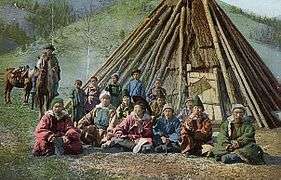 Altai people
Altai people
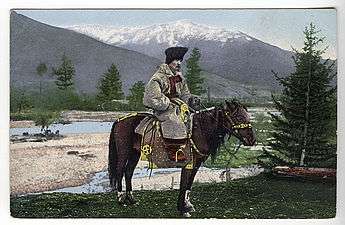 Altai man in national suit on horse
Altai man in national suit on horse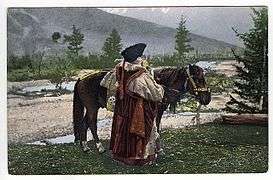 Altai woman in national dress
Altai woman in national dress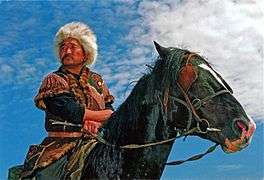 Altaian horseman
Altaian horseman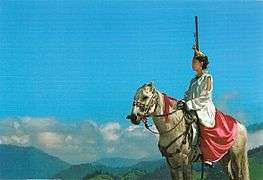 Altaian woman
Altaian woman
Demographics
According to the 2010 Russian census, there was a total of 69,963 Altaians who resided within the Altai Republic. This represented 34.5% of the total population of the republic, compared with 56.6% with a Russian background, Altaian families are the majority only in certain villages. However, Altaian culture is still the local culture between people and communities.
Culture
Traditional lifestyle
The Southern Altaians were mostly nomadic or semi-nomadic livestock holders. They raised horses, goats, sheep, and cattle. The Northern Altaians mainly engaged in hunting as their primary form of subsistence. Their main prey were animals from the taiga (boreal forests). However, some Altaians also engaged in small-scale agriculture, gathering, and fishing.[7]
Dwellings
Most of the Southern Altaians traditionally lived in yurts. Many Northern Altaians mainly built polygonal yurts with conic roofs made out of logs and bark. Some Altai-Kizhi also lived in mud huts with birch bark gable roofs and log or plank walling. The Teleuts and a few Northern Altaians lived in conic homes made out of perches or bark. With the influx of Russians near the homeland of the Altaians, there was an increase of the construction of large huts with two to four slope roofs in consequence of Russian influence.[7]
Despite the many social and political changes the Altaians have endured, many modern and settled families still keep a yurt in their yards. These yurts are usually used as a summertime kitchen or extra room.[14]
Clothing
The traditional clothing of Southern Altaian men and women are very similar with little differences between the two. Average clothing consisted of long shirts with wide breeches, oriental robes, and sleeves. Other apparel often included fur hats, high boots, and sheepskin coats. Northern Altaians and some Teleuts traditionally wore short breeches, linen shirts, and single-breasted oriental robes. Despite the fact that most Altaians today wear modern clothes, traditional wear still remains in use.[3]
Cuisine
Altaian cuisine consists of soups of horseflesh or mutton. Dishes with gopher, badger, martmot, fermented milk, cream (from boiled milk), blood pudding, butter, fried barley flour, and certain vegetables are also staples of Altaian cuisine. Popular drinks include aryki (milk vodka).[3]
Religion
History
Traditional Altaian shamanism is rich with mythology and supernatural beings. Popular deities included Yerlik, the god of the underworld and Oyrot-Khan, a sagely and heroic figure who is a composite blend taken from historical Zungarian (Oirat) Khans and ancient legendary heroes. However, with many migrations, settlement changes, and the presence of the Russians and their eventual union with the Russian Empire, the Altaians encountered three world religions: Islam, Buddhism, and Christianity. At first, the Altaians were indifferent and at times even hostile to these faiths and their expansion. In 1829, a Orthodox mission was founded in the region (modern Altai Republic) as part of it being a protectorate of the Russian Empire.[3] Orthodox missionaries often confiscated land from Altaians who refused to convert.[15] Other Altaians were forcefully converted to Christianity.[16] Mongolian Buddhist missionaries attempted to spread the faith among the Altaians during the 19th century. The Buddhist missionaries also encouraged the Altaians to unite together against the Russians. However, their activities and preaching were suppressed by the Russian state and Christian missionaries. Buddhism made little headway among the Altaians but many Buddhist ideas and principles entered into Altaian spiritual thought.[15]
The mission and its missionaries were initially culturally sensitive and tolerant to the Altaians and their customs. However, the rise of Russian nationalism during the late nineteenth century caused the Russification of Orthodox Christianity and the mostly Russian clergy in Siberia also took up the ideology. This created intolerant views of the natives of Siberia (including the Altaians) and of their culture. This led to the rejection of Christianity by many Altaians who saw it as a foreign Russian religion. However, Russian rule continued to grow increasingly strict both politically and religiously.[3]
Around 1904, the development of Burkhanism among the Altaians was underway. Burkhanism is a monotheistic religion named after Ak-Burkhan, a deity who is believed and recognized by adherents to have been the sole god. Burkhanism was opposed to both the Russians and the traditional shamans. The hostility towards the shamans was so great that the shamans had to seek protection from Russian authorities. The rise of the Bolsheviks in the first quarter of the twentieth century also led to the brutal repression of all religions which included the faiths in the Altai region. For the next few decades, most religions basically vanished with only shamanistic and ancient polytheistic beliefs surviving the chaos. This was believed to have occurred because ancient religious beliefs could be easily orally transmitted from generation to another. It's also likely that no Burkhanist texts survived the repression and main sources for the beliefs of the religion come from Russian missionaries, travellers, and scholars.[3]
Modern spirituality
Recently, Burkhanism and shamanism has seen a revival in the Altai region which is especially popular among Altaian youth. At present, the majority of Kumandins, Tubalars, Teleuts, and Chelkans are Russian Orthodox although there is a significant minority that practice shamanism. Shamanism is practiced by many Telengits though there is a large amount that also profess Orthodox Christianity. Burkhanism is the main religion of the Altai-Kizhi but there is a significant number of Orthodox Christians.[3] A few Altaians also practice Sunni Islam and Tibetan Buddhism.[14][17]
See also
Notes
- Russian Census 2010: Population by ethnicity Archived 2012-04-24 at the Wayback Machine (in Russian)
- Olson, James Stuart (1998). An Ethnohistorical Dictionary of China. Greenwood Publishing Group. pp. 9–11. ISBN 978-0-313-28853-1.
- Skutsch, Carl, ed. (2005). Encyclopedia of the World's Minorities. New York: Routledge. pp. 81–83. ISBN 1-57958-468-3.
- Ethnic history, History of a region, Statistic information at http://eng.altai-republic.ru/index.php Archived 2011-07-17 at the Wayback Machine
- NUPI Centre for Russian Studies http://www2.nupi.no/cgi-win//Russland/etnisk_b.exe?Altai Archived 2007-09-30 at the Wayback Machine
- Flegontov, Pavel; Changmai, Piya; Zidkova, Anastassiya; Logacheva, Maria D.; Altınışık, N. Ezgi; Flegontova, Olga; Gelfand, Mikhail S.; Gerasimov, Evgeny S.; Khrameeva, Ekaterina E. (2016-02-11). "Genomic study of the Ket: a Paleo-Eskimo-related ethnic group with significant ancient North Eurasian ancestry". Scientific Reports. 6: 20768. arXiv:1508.03097. Bibcode:2016NatSR...620768F. doi:10.1038/srep20768. ISSN 2045-2322. PMC 4750364. PMID 26865217.
- Skutsch, Carl, ed. (2005). Encyclopedia of the World's Minorities. 1. New York: Routledge. p. 82. ISBN 1-57958-468-3.
- C.P.Atwood- Encyclopedia of Mongolia and the Mongol Empire, p.9
- "People from Russia — Interviews on the Streets", Way To Russia, 24 September 2003
- Znamenski, Andrei A. (2014-06-30). "Power for the Powerless : Oirot/Amursana Prophecy in Altai and Western Mongolia, 1890s-1920s". Études mongoles et sibériennes, centrasiatiques et tibétaines (45). doi:10.4000/emscat.2444. ISSN 0766-5075.
- Kolga et al., The Red Book of the Peoples of the Russian Empire, p. 29
- "Altay" Archived 2006-04-24 at the Wayback Machine, Centre for Russian Studies, NUPI, retrieved 17 October 2006
- "Altai Republic :: official portal". Archived from the original on 2006-08-13. Retrieved 2006-10-24.
- Winston, Robert, ed. (2004). Human: The Definitive Visual Guide. New York: Dorling Kindersley. p. 429. ISBN 0-7566-0520-2.
- West, Barbara A. (2010). Encyclopedia of the Peoples of Asia and Oceania. Infobase Publishing. pp. 39–42. ISBN 978-1-4381-1913-7.
- Minahan, James B. (2014). Ethnic Groups of North, East, and Central Asia: An Encyclopedia. ABC-CLIO. pp. 11–13. ISBN 9781610690188.
- Akiner, Shirin (1986). Islamic Peoples of the Soviet Union: With an Appendix on the non-Muslim Turkic peoples of the Soviet Union. London: Routledge. p. 417. ISBN 0-7103-0025-5.